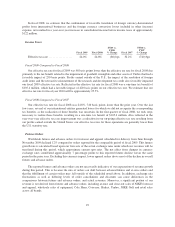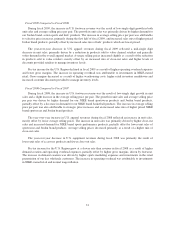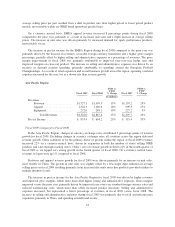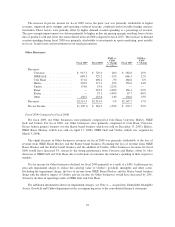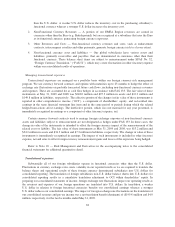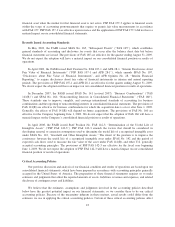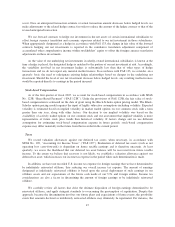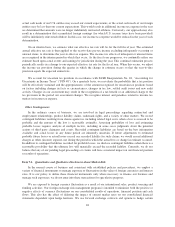Nike 2009 Annual Report Download - page 41
Download and view the complete annual report
Please find page 41 of the 2009 Nike annual report below. You can navigate through the pages in the report by either clicking on the pages listed below, or by using the keyword search tool below to find specific information within the annual report.Managing translational exposures
To minimize the impact of translating foreign currency denominated revenues and expenses into U.S.
dollars for consolidated reporting, certain foreign subsidiaries use excess cash to purchase U.S. dollar
denominated available-for-sale investments. The variable future cash flows associated with the purchase and
subsequent sale of these U.S. dollar denominated securities at non-U.S. dollar functional currency subsidiaries
creates a foreign currency exposure that qualifies for hedge accounting under FAS 133. We utilize forward
contracts and options to partially, or entirely, hedge the variability of the forecasted future purchases and sales of
these U.S. dollar investments. This has the effect of partially offsetting the year-over-year foreign currency
translation impact on net earnings in the period the investments are sold. Hedges of available-for-sale
investments are accounted for as cash flow hedges. The fair value of instruments used in this manner at May 31,
2009 and 2008 was $103.6 million and $7.8 million in assets and $0 and $14.4 million in liabilities, respectively.
The effective portion of the changes in fair value of these instruments is reported in OCI and reclassified into
earnings in other (income) expense, net in the period during which the hedged available-for-sale investment is
sold and affects earnings. Any ineffective portion, which was not material for any year presented, is immediately
recognized in earnings as a component of other (income) expense, net.
For fiscal 2009, we estimate that the combination of foreign currency conversion gains in other (income)
expense, net and the modestly favorable translation of foreign currency-denominated profits from our
international businesses resulted in a year-over-year increase in consolidated income before income taxes of
approximately $124 million.
Refer to Note 18 — Risk Management and Derivatives in the accompanying notes to the consolidated
financial statements for additional quantitative detail.
Net investments in foreign subsidiaries
We are also exposed to the impact of foreign exchange fluctuations on our investments in wholly-owned
foreign subsidiaries denominated in a currency other than the U.S. dollar, which could adversely impact the
U.S. dollar value of these investments and therefore the value of future repatriated earnings. During fiscal 2008,
we began to hedge certain net investment positions in Euro-functional currency foreign subsidiaries to mitigate
the effects of foreign exchange fluctuations on net investments, with the effect of preserving the value of future
repatriated earnings. In accordance with FAS 133, the effective portion of the change in fair value of the forward
contracts designated as net investment hedges is recorded in the cumulative translation adjustment component of
accumulated other comprehensive income. Any ineffective portion, which was not material for any year
presented, is immediately recognized in earnings as a component of other (income) expense, net. To minimize
credit risk, we have structured these net investment hedges to be generally less than six months in duration. Upon
maturity, the hedges are settled based on the current fair value of the forward contracts with the realized gain or
loss remaining in OCI; concurrent with settlement, we enter into new forward contracts at the current market
rate. The impact of net investment hedges reflected in OCI was a pre-tax gain (loss) of $161.4 million and
($68.6) million in 2009 and 2008, respectively. Cash flows from net investment hedge settlements totaled $191.3
million and ($76.0) million in 2009 and 2008, respectively.
Liquidity and Capital Resources
Cash Flow Activity
Cash provided by operations was $1.7 billion for fiscal 2009 compared to $1.9 billion for fiscal 2008. This
decrease was mainly due to an increase in cash used for our working capital as a result of lower accounts payable
and a higher accounts receivable balance. The decrease in accounts payable was primarily due to lower purchases
of inventory as well as a reduction in overall spending. The higher accounts receivable balance is a result of a
longer collection cycle, reflecting a more challenging retail environment experienced by our customers in the
EMEA and U.S. regions.
39


